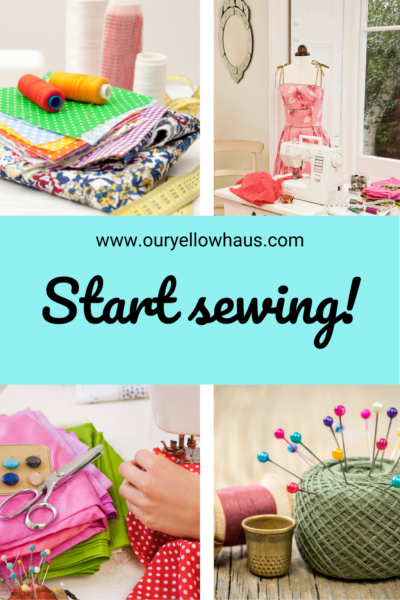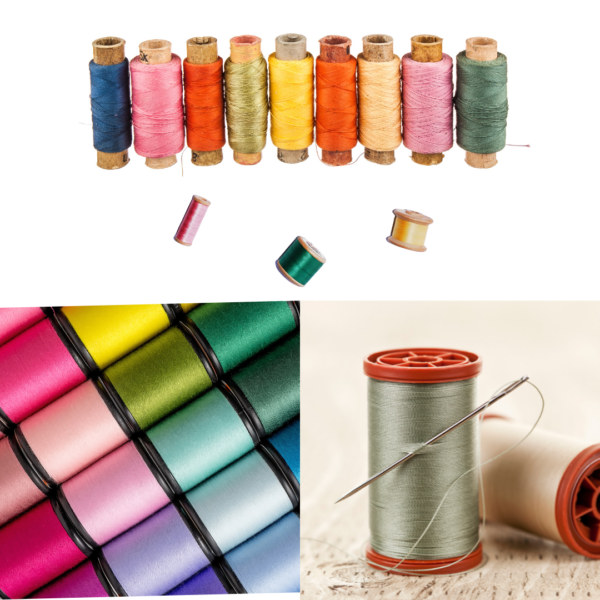Do you want to try sewing but you do not know where to start? This is your solution. A list of 12 things that you need to start sewing.
Here is the truth, my friend, you do not really need all the fancy stuff so you could get started. In fact, you may not need all of the things mentioned in this list. I remember just buying the sewing machine (it usually comes with a few bobbins, a seam ripper, and needles), threads, straight pins, and a good pair of scissors.


Here’s a list of the things that you need to finally start sewing:
SEWING MACHINE
This is my Singer Simple 3210. This sewing machine has churned hundreds of pillow covers, bed sheets, duvet covers, drawstring bags and more for my small home business in the last 4 years or so. It has been working well with regular cleaning and care.


Its basic functions introduced me to sewing smoothly. Choosing a sewing machine could be overwhelming. If you are planning to buy one, choose a simple, sturdy one that does the job. You only need to master a straight stitch and a zigzag as a beginner. Any fancy additional feature might hinder you from learning the basics. Do not rush. You will upgrade your sewing machine as your skills grow.
SCISSORS
There are many types of scissors. Get the one that’s identified for fabric use. Hold it, feel it before buying. This is to make sure that you are comfortable with the design and weight. Go home after buying The Scissors, gather your folks, and let them know that your new sewing powers make you self-destruct once you see them use The Scissors being used on a material other than fabric.
No, I am not kidding.
This meme should get your message across. 🙂


Scissors can last for a really long time when used properly.
PINKING SHEARS
You use these saw-toothed shears or you apply a zigzag stitch on the fraying edge of your woven cloth. Actually, there are various ways to keep your fabric from fraying. I am eager to share that in another post soon. A pinking shear will not prevent fraying, though. It will only minimize damage.


THREADS
Threads vary in color, thickness, and quality. Get yourself a strong, good-quality polyester thread that does not break or fray easily. Ask your local craft store for a good brand (e.g. Coats & Clark Dual Duty general purpose thread) that is available in your area.
It is very common to find threads in bundles or in one kit with assorted colors at a discount price. Be careful before buying those. A thread with a cheap price is just that. A cheap thread.
If you want to know the humble beginnings of threads, Check out https://suzyquilts.com/how-is-thread-made/s. It’s a long but sweet read.


MEASURING TAPE, RULER, STEEL TAPE (optional)
Every measuring material has a special purpose. As a beginner, start with a 1-foot ruler and a tape measure. A ruler can be used for small projects; a soft and flexible tape can be used for general purposes and for taking body measurements.
A steel measuring tape is optional. I use this to measure the length and width of windows and mattresses (when I am making curtains and fitted sheets).


TIP: Your measuring material should be durable, non-stretchy, marked clearly, scaled for inches and centimeters, and scaled from the edge.
HAND-SEWING NEEDLES AND THIMBLE
Some projects will require you to finish with a simple hand-sewing stitch. Get the one that is intended for all-purpose hand-sewing and is labeled “Sharp”. These needles have a sharp point, a thin diameter, and a short round eye.
As a general rule – the bigger the number the finer the sewing needle. Choose between sizes 6, 7, 8, 9, and 10 for light to medium fabrics.
A thimble is a “pushing” cap worn on the finger during hand-sewing. It protects the finger from the eye end of the needle. Observe your fingers while hand-sewing. Put the thimble on the finger that pushes the needle. My advice: You can skip the thimble for now if you feel that you are not going to do a lot of hand-sewing.


FABRIC MARKER OR TAILOR’S CHALK
I’ll be honest. I do not own one. Oh wait, I think I have one but I do not where it is. I’ve been using my son’s colored pencils–the erasable sort– because they are everywhere. I am sure there is at least one under the sofa bed right now while I am typing this post. They’ve been useful. So far, so good.


STRAIGHT PINS, PIN CUSHION AND CLIPS
I did not start my sewing hobby with a fancy pincushion on my wrist. Whenever I see one, I say, “Aww so cute.” And then, I look at it with the eyes of a structural engineer and say, “Looks so easy. I could definitely make this instantly!” (*cricket sounds for many months*) Eventually, it did happen. With the gazillion other little sewing projects that I had in my mind, there was just “sew” many things to make and “sew” little time!
Ok, pins. They are essentials. Have lots of PINS, PINS, and PINS. Period. Use clips for delicate fabrics that may get damaged by using pins.


SEAM RIPPER
A seam ripper is a must-have item in sewing. It is used to undo stitches, open seams, cut threads and remove buttons. This nifty tool usually comes as part of a package when you buy your sewing machine.
TIP: Get the one that has a flat handle because things have a mind of their own. They move and roll and hide and go missing the moment they are needed. Buy two.


BOBBINS
Check your sewing machine manual for the type of bobbin used. There are more than 50 types of bobbins but your sewing machine is designed to use only ONE type. Also, if your sewing machine came with a few bobbins, you can take a bobbin with you to the store so you can be sure that you are buying the right one.


SEWING MACHINE NEEDLES
Choosing a needle is a serious business. There are many options but choosing the right needle to start sewing should not be a burden. The different kinds of needles are Universal, Jersy/Ballpoint, Jeans/Denim, Leather, Sharp, etc.
Your best option as a beginner is the Universal needle which can be used for almost all kinds of fabrics. As for the needle size, the rule of thumb is the lighter the fabric the smaller the needle size, the heavier the fabric the bigger the needle size.


Needle size is represented by two numbers (European sizing system/American sizing system). The European sizing system is numbered from 60 to 110. 60 is for lightweight fabrics like chiffon and 100 is for heavy material such as leather. The American sizing system is numbered from 8 to 18, where 8 is for the lightweight fabrics and 18 for the heavyweight fabrics.
In the image above, a 90/14 size is for medium weight fabrics such as quilting fabrics, cotton, velvet, knits, light wool, sweatshirt, and fleece. Get yourself a packet of this size.
For best sewing machine needles, click here.
TIP: For best results, change your needle after 8-10 hours of stitching time. Do not remove the needles from the original packaging with readable sizing labels.
FABRICS
The last item to have so could finally start sewing is a piece of fabric. You can buy your first yard but you do not need to. Remember that you can recycle available fabrics in your home. You can use old curtains, duvet covers, flat sheets, old clothes, fabric table cloths, etc. It does not matter if you like the print or not. Just measure, cut, sew, make some mistakes, learn and have fun.


WARNING: Fabric addiction is real. The problem is not “how” to choose the right fabric for your project, but “where” to store aaaall the fabrics that you will accumulate once you are bitten by the sewing bug.
And here is more…
Some experienced sewists may say that you need a rotary cutter, a cutting mat, seam gauge, etc. and they are right. As you tackle more sewing projects you will slowly build your essentials. So, relax.
Lastly, I strongly recommend getting yourself a storage box. (I started with a sturdy shoebox with 3 transparent plastic food containers inside.) Because sewing, like our lives, is not fun when we spend too much time searching for the missing tailor’s chalk, that thread that matches our fabric, or that extra bobbin.
Another thing that you will need is steam iron for pressing your seams and folds. I did not include the iron in the list because I am sure you have that at home already.
What matters most…
Apart from the 12 things that you need to start sewing, what you will need is PATIENCE. Lots of it.
Give yourself time enough time to learn. Start small. Finish small projects and feel that sense of accomplishment before you move to more complicated ones. Make some quick, useful projects for your home, yourself, and your loved ones. The more you see and enjoy the benefits of sewing the more you will fall in love with it.
CLICK THESE TUTORIALS ON HOW TO MAKE BED PILLOWCASES, DRAWSTRING BAGS, AND SCRUNCHIES. THESE TUTORIALS ARE PERFECT FOR ABSOLUTE BEGINNERS.
I can give you a long list of why you should pick up the happy, colorful world of sewing as a hobby. Do you know that you can make it a second career or a profitable business? Do you want to know the healthy benefits of this hobby?
Stay with me and let’s explore that in my next post.




Pingback: WHY SEWING IS GOOD FOR YOUR HEALTH AND LIFE - Our Yellow Haus